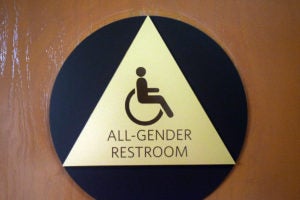Stanford increases the number of all-gender restrooms on campus
Single-user restrooms throughout the university are being converted to all-gender facilities in recognition of the needs of people who are transgender, gender fluid and gender non-conforming.
Although the university’s efforts predate the passage of a California law that mandates such conversion in public buildings, it is in concert with the law’s intent and implementation.
Gov. Jerry Brown signed the state law, Assembly Bill 1732, in September 2016 as part of the state’s efforts to recognize its transgender, gender fluid and gender non-conforming residents. It requires single-user toilet facilities open to the public to be identified as all-gender. The law also benefits people with disabilities who may need the help of personal assistants of a different gender, as well as families with children of different genders. The law became effective in March.
Student requests
The university’s efforts are the result of meetings held between Stanford transgender students and former Provost John Etchemendy. Etchemendy agreed to the students’ request that the university make available more all-gender bathrooms to increase their comfort and safety on campus, according to Sheila Sanchez, associate director of the Diversity & Access Office, under whose auspices much of the conversion is being conducted.
As a result, an implementation advisory group was formed that included the Diversity & Access Office; the Vice Provost for Student Affairs; University Human Resources; Land, Buildings and Real Estate; the Department of Athletics and Recreation (DAPER); and Residential & Dining Enterprises. Guidelines were created to address all-gender facilities in new construction and existing facilities, and a program was funded for most buildings to address necessary changes.
Between now and the end of the calendar year, signs on single-occupancy men’s and women’s restrooms in most campus buildings will be converted to all-gender signs. Unisex signs, with pictograms of a man and woman, will also be converted to the more inclusive all-gender sign standard, according to Torrey Spies, associate director of space planning and management, whose office has helped in the signs’ design.
In some areas, including the university’s athletic facilities, conversion is well underway. DAPER has converted 14 facilities, according to Ray Purpur, deputy athletic director, and is studying the possibility of creating some all-gender locker rooms.
Neither the university’s efforts nor state law applies to multiple-user bathroom facilities in academic and administrative buildings.
All-gender facilities are also called gender-neutral and gender-inclusive facilities. They can include restrooms, showers, locker rooms and changing rooms that are usable by persons of all gender identities, while still providing privacy and security for individuals.
Going forward, all new construction on campus will include at least one single-occupancy, all-gender restroom. In addition, existing buildings without these facilities will continue to be evaluated for renovation should there be no appropriate single-use restrooms to convert. Priority will be given to highly public spaces, followed by academic/classroom and lab spaces and then administrative buildings.
Residential improvements
The move toward more inclusivity in facilities at Stanford in general dates back to 2007, when Residential Education and Residential & Dining Enterprises implemented a pilot project making gender-neutral housing assignments available to interested students. Those efforts made Stanford a national leader in giving students of different genders the opportunity to live together.
While those efforts have been expanded, the two organizations have also stepped up by providing more all-gender bathrooms, including multiple-user, communal bathrooms, in student residences. For 2017-18, all-gender bathrooms will be available in most residences, including Branner, Crothers, EAST, Florence Moore, FroSoCo, most of Lagunita, Lantana, Murray, Ng, Potter, Robinson, Roble, Stern, Wilbur and Yost.
The new communal bathrooms offer enhanced privacy through fully enclosed toilet and shower stalls, separate showering and changing areas, and urinal removal. Students who choose to use those bathrooms may find themselves brushing their teeth next to students of a different gender, just as they might at home with siblings.
Surveys done by Student Housing Operations show that students support all-gender communal-use bathrooms, in addition to the female- and male-designated bathrooms already widely available. In fact, several residences that offer communal living, including residences on the Row, have historically been gender neutral throughout. All-gender bathrooms have also been available for many years at some upper-class residences, including Crothers, which features singles and one-room doubles.
“So many of the residences already have a single-use bathroom with a toilet, sink and shower,” said Koren Bakkegard, associate dean of residential education, who has studied residential options with Justin Akers, undergraduate housing assignments manager. “These are quite private, and they have often also been the disability accommodation bathroom. For many years in most buildings they have been labeled gender neutral.”
Communal bathrooms
The issue in the residences, Bakkegard said, has, instead, been whether multi-user communal bathrooms should be all-gender. Transgender students indicated to Etchemendy in 2016 that expansion of bathroom options was a top priority.
“We asked them: What is the most important thing to you in relation to the residences? They said having access to gender-inclusive bathrooms to increase their sense of safety and inclusion,” Bakkegard said. “They want an option where they don’t feel judged and that doesn’t require the decision trees many have had to use to find a bathroom in the past.”
The way to think about this in the residences is that there really are three different types of bathrooms – men’s, women’s and all-gender, said Bakkegard. “What we are trying to do is ensure that any given student doesn’t have to go up or down more than one floor or have to go through a common area to get to the facility they prefer.”
Bakkegard said that once students are situated in a residence, they quickly adapt to whatever configuration of facilities they find.
“The students respond to this easily and flexibly,” she said. “It’s working really well. But the bottom line is that people shouldn’t be overly concerned about the changes. Students will be guaranteed access to the bathroom of their choice.”

